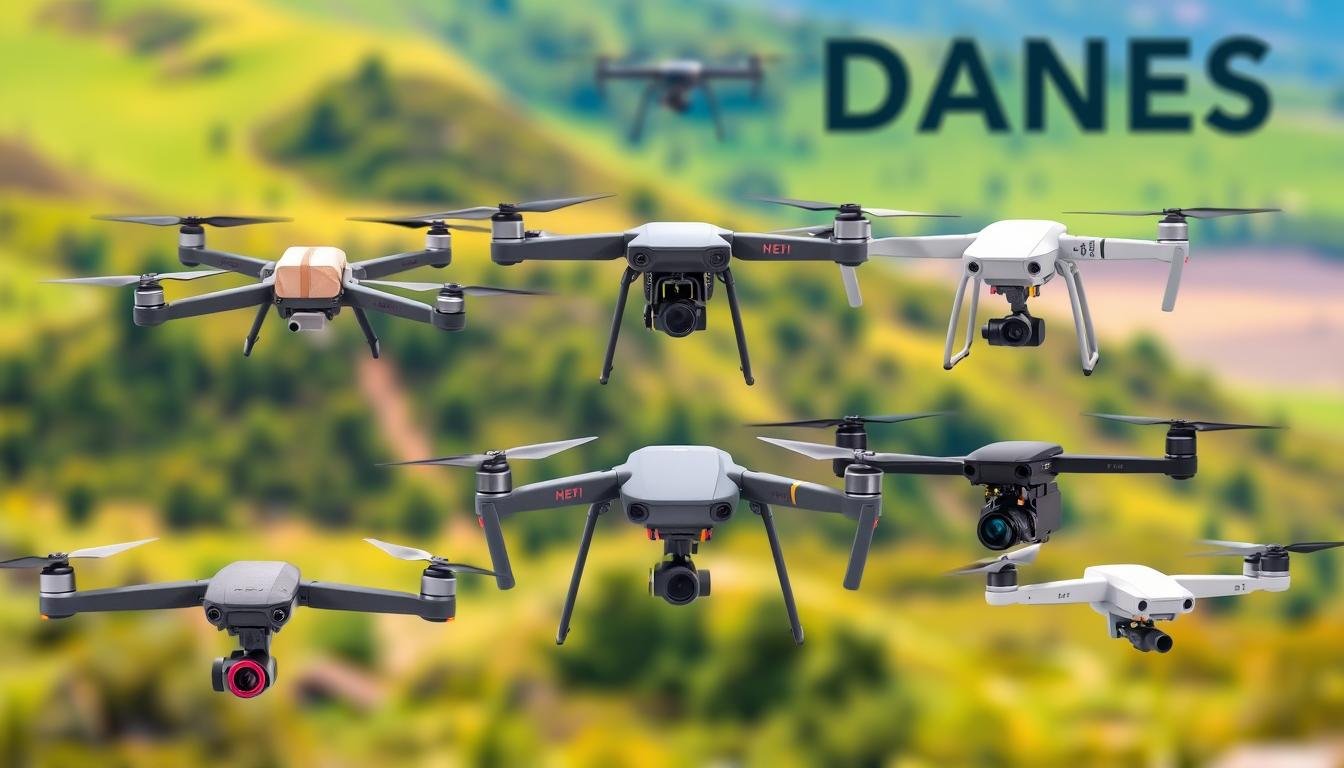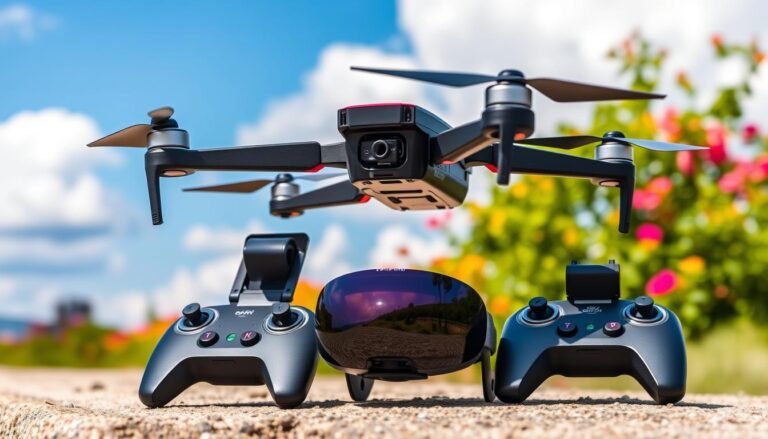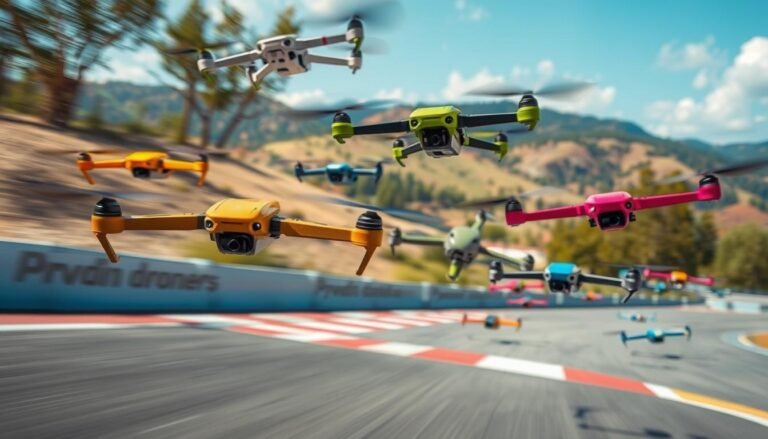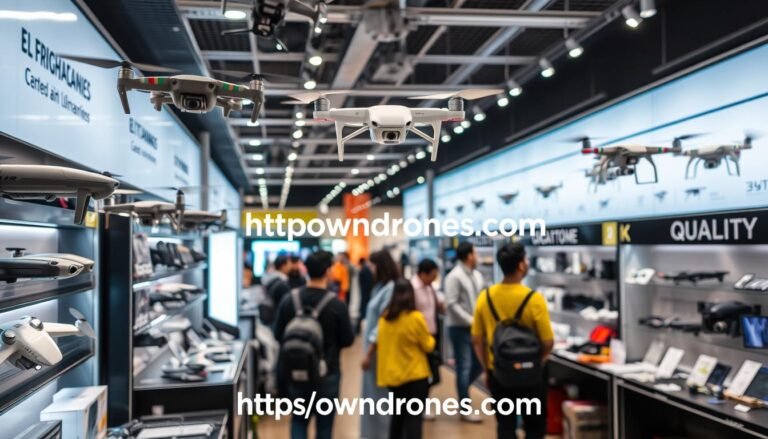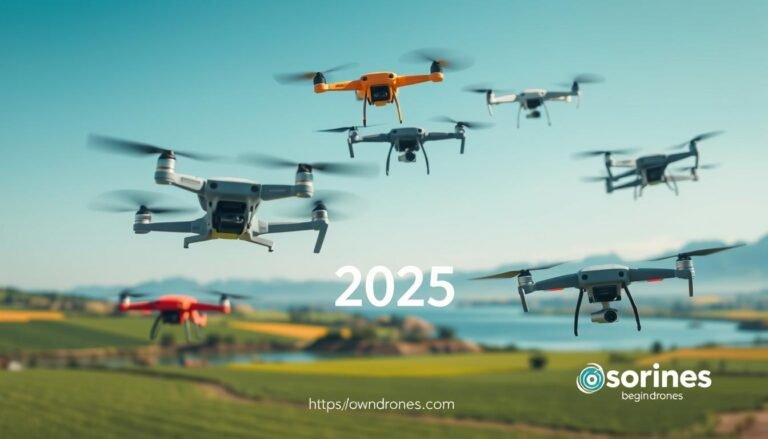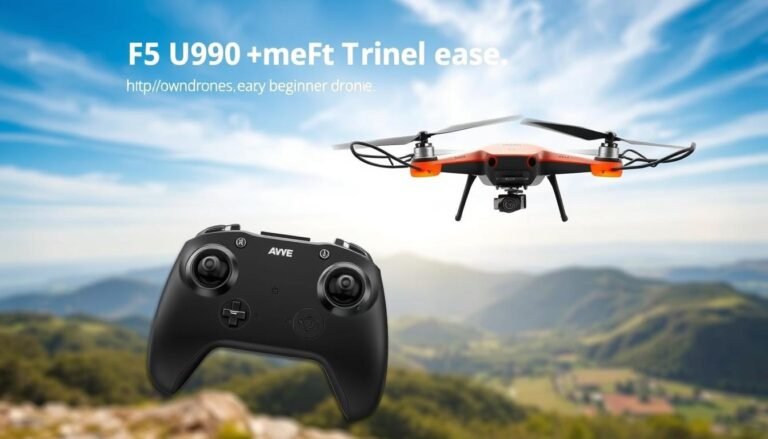What Do Non-Military Drones Carry? Discover the Payload
I’ve always been curious about what non-military drones can carry. I learned that a drone’s payload is how much extra weight it can carry. This can include cameras, sensors, or even packages.
It’s important to know what a drone can carry based on its type and use. For example, multi-rotor drones are great for taking pictures from the air. Fixed-wing drones can fly longer and carry more.
Knowing what drones can carry helps us see their full power. The drone market is growing fast. It’s expected to be over USD 169.7 billion by 2033.
Key Takeaways
- Drones can carry various payloads, including cameras, sensors, and delivery packages.
- The payload of a drone is defined as the weight it can carry, excluding its own weight.
- Drone payload capabilities vary depending on the type of drone and its intended use.
- Understanding drone payload capabilities is key to seeing the full power of civilian drones.
- The global UAV market size is expected to exceed USD 169.7 billion by 2033.
- Following aviation rules is important to stay safe when using drones.
Understanding What Do Non-Military Drones Carry: A Basic Overview
Exploring non-military drones, I find them amazing. They carry non-defense drone payloads like photos and cargo. The drone carrying capacity decides what they can carry.
There are many types of drones. Single-Rotor Helicopter Drones and Multi-Rotor Drones are popular. Fixed-Wing Drones and Fixed-Wing Hybrid VTOL Drones also exist. Each has its own special features and UAV cargo options.
Here are some key features of different drone types:
- Multi-Rotor Drones: easy to use, great for photos and videos
- Fixed-Wing Drones: need runways, look like airplanes
- Fixed-Wing Hybrid VTOL Drones: fly like planes and helicopters
Knowing about drone carrying capacity and non-defense drone payloads helps pick the right drone. With new tech, drones can carry more. They can even carry heavy stuff.
In conclusion, non-military drones are very useful. Knowing about their drone carrying capacity and non-defense drone payloads is key. As tech gets better, we’ll see more cool UAV cargo options.
| Drone Type | Payload Capacity | Flight Duration |
|---|---|---|
| Single-Rotor Helicopter Drones | Heavier payloads | Extended flight durations |
| Multi-Rotor Drones | Smaller loads | Shorter flight instances |
| Fixed-Wing Drones | Varies | Longer flight durations |
The Evolution of Civilian Drone Cargo Capabilities
Drones have changed a lot in the last ten years. They are now cheaper and easier to use. This has made them popular in many fields. The commercial drone cargo area has grown a lot. Companies use drones to send goods to hard-to-reach places.
The recreational drone payload capacity has also grown. This lets hobbyists try new things like taking pictures from the sky. Drones can now do many things, like help farmers and watch over nature.
Some cool things drones can do include:
- Precision farming: using cameras and sensors for better field planning
- Environmental monitoring: watching wildlife and fighting poaching
- Search and rescue: finding missing people fast
The future of civilian drone cargo looks bright. The drone market is expected to grow even more. We will see more cool uses of commercial drone cargo and recreational drone payload capacity. This will change how we live and work.
Essential Components of Drone Payload Systems
Drone payload systems have key parts. Knowing these parts helps drones carry more. It lets them use UAV cargo options better.
Drone payload systems include mounting, weight, and balance. A good mounting system keeps the payload safe. Weight and balance tech keep the drone steady.
Some drones, like the Insitu ScanEagle, can carry up to 35 pounds. Small drones, like personal ones, carry less than 10 pounds.
Drone cargo options are many. They can deliver, spy, or take photos. The right drone and payload depend on the job’s needs.
| Drone Type | Weight | Payload Capacity |
|---|---|---|
| Small drones | Up to 1,000 grams (2.20 pounds) | Up to 0.5 pounds |
| Medium drones | Up to 44 pounds | Up to 10 pounds |
| Large drones | More than 44 pounds | Up to 500 pounds |
Commercial Delivery Drone Payload Specifications
When it comes to commercial drone cargo, how much it can carry is key. Drone delivery payloads can be small or big. The drone must fit the weight and size of what it carries.
Mini drones can carry up to 100g. Small drones can carry from 100g to 1kg. But, commercial drones can carry much more, up to 50kg or more.
DJI drones can carry from 1kg to 30kg. Ehang drones can carry from 100kg to 220kg. The right drone depends on the delivery needs.
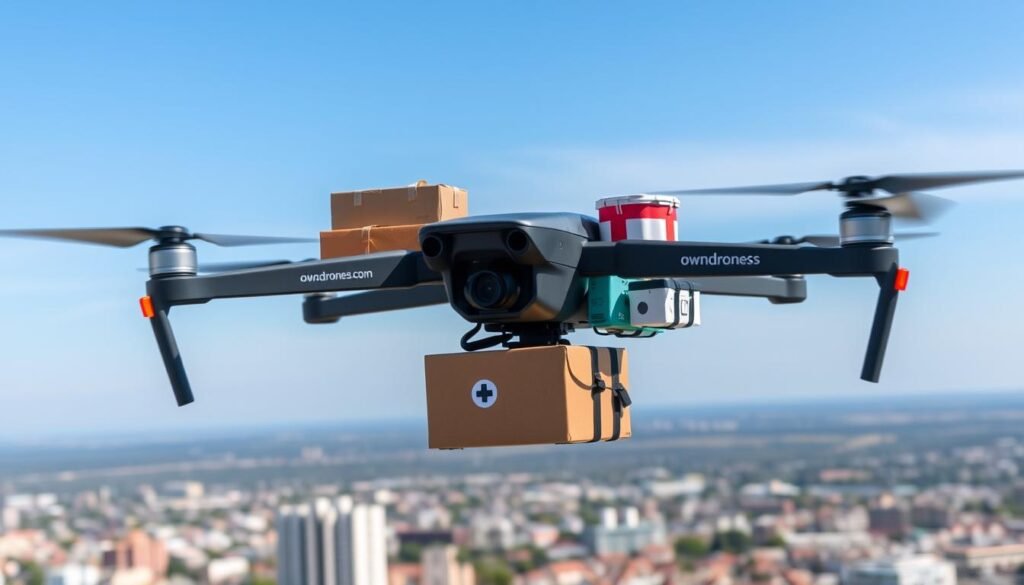
Choosing the right drone for cargo is important. It depends on the cargo, the route, and if special gear is needed. By picking the right drone and payload, businesses can make their delivery work better.
Camera and Imaging Equipment Payloads
Exploring what-do-non-military-drones-carry shows us many camera and imaging payloads. These payloads help drones carry out tasks like aerial photography and surveying. They are used in many fields.
Non-military drones can carry small thermal imaging cameras. These cameras weigh 100 to 500 grams. They are great for checking buildings, finding heat leaks, or watching wildlife.
The FLIR Thermal camera (Vue Pro) is a favorite for drone thermal imaging. It weighs about 250 grams. There are also mid-range and high-end cameras for better quality, but they are heavier and cost more.
- High-resolution sensors for detailed images and videos
- Stabilization systems for smooth footage
- Zoom for capturing distant scenes
- Low-light sensitivity for tough lighting
These advancements let drones do complex tasks with more precision. As drone tech grows, we’ll see more uses for what-do-non-military-drones-carry. This will expand what civilian drones can carry and do.
| Camera Type | Weight Range | Applications |
|---|---|---|
| Compact Thermal Imaging Cameras | 100-500 grams | Infrastructure inspection, wildlife tracking, heat leak detection |
| Mid-range Thermal Imaging Cameras | 500 grams-1.5 kilograms | High-resolution thermal imaging, industrial inspection, search and rescue |
| High-end Thermal Imaging Cameras | 1.5-2.5 kilograms | Scientific research, high-altitude surveillance, advanced industrial inspection |
Agricultural and Environmental Monitoring Payloads
Non-defense drone payloads are used for many things. UAV cargo options now include sensors for checking crops and the environment. The drone carrying capacity has grown, letting drones carry more.
Drones help farmers check crop health and survey fields. They use multispectral and RGB cameras for this. Drones also track wildlife, deforestation, and climate changes.
Using drones for farming and the environment has many benefits. It makes things more efficient and cheaper. With UAV cargo options like sensors and cameras, data is gathered fast and right.
Some key features of drone payloads for farming and the environment are:
- High-resolution cameras for crop health and field surveys
- Thermal sensors for finding heat and tracking wildlife
- Multispectral cameras for spotting plant stress
- Advanced sensors for air and water quality checks
Non-defense drone payloads are very important for farming and the environment. Their use is growing and will keep growing.
Scientific Research and Data Collection Equipment
Non-military drones are used for many things, like scientific research and data collection. They can carry many tools, like weather monitoring tools and environmental sampling devices. This helps with studying the weather and the environment.
Drones can now carry more, like cameras and sensors. This lets them do more research, like tracking climate change and natural disasters. They can even do environmental surveys.
Weather Monitoring Tools
Drones have tools to check the weather, like anemometers and barometers. They help predict the weather and track climate change. They also help with disaster tracking.
Environmental Sampling Devices
Drones collect samples, like air and water, to check pollution. They help track climate change and do environmental surveys. They can carry many types of sampling devices.
Research Instruments
Drones have tools for research, like cameras and sensors. They help study climate change, natural disasters, and the environment. They can carry more now, so they can do more complex research.
| Equipment | Description |
|---|---|
| Weather monitoring tools | Anemometers, barometers, hygrometers |
| Environmental sampling devices | Air and water samplers |
| Research instruments | Cameras, sensors, thermal imaging devices |
Maximum Weight Considerations and Limitations
When we talk about what-do-non-military-drones-carry, how much they can carry is key. The weight a drone can lift depends on its design, size, and drone payload capabilities. Civilian drone cargo can range from small items to big equipment. Knowing the max weight is vital for safe flying.
The max weight a drone can carry depends on a few things. These include the drone’s type, how it moves, and what it’s made of. For instance, a drone made for carrying things can carry more than one for taking pictures. It’s important to think about these when picking a drone for a job.
Some important things that affect how much a drone can carry include:
- Drone size and design
- How it moves
- What it’s made of
- Battery life and size
Knowing these things and the max weight is key for safe flying. By picking the right drone for the job, users can use their drone payload capabilities well. This helps them reach their goals.
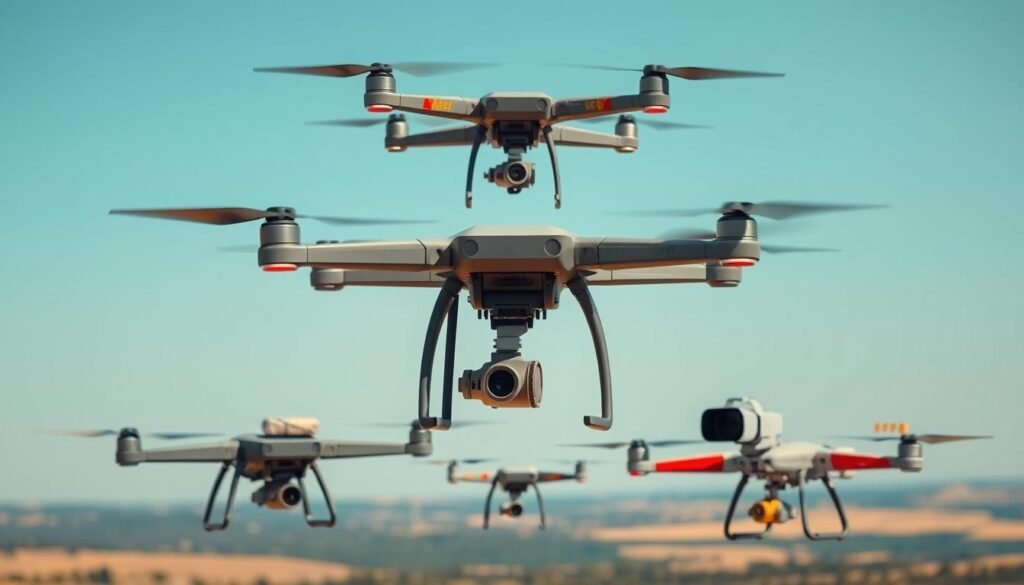
Safety Features and Payload Security Systems
Exploring non-defense drone payloads shows how vital safety and security systems are. They help avoid accidents and keep UAV cargo safe. A study on drone safety and security found a big drop in accidents and cost savings.
The drone’s carrying capacity is key to what it can carry. New tech lets drones have safety features and protect their cargo. Statistical data shows drones help farms work better and respond faster in emergencies.
- Autonomous navigation systems
- Collision avoidance systems
- Payload encryption and secure data transmission
- Emergency landing protocols
These features are vital for safe and secure drone cargo transport. As drones become more common, focusing on safety is essential. It helps avoid accidents and makes goods transport more efficient.
Regulatory Requirements for Different Payload Types
Exploring drone payload capabilities shows how key it is to know the rules. The Federal Aviation Administration (FAA) sets the rules for drones. To fly a drone with a certain load, you must follow these rules, like those in Part 107.
How much a drone can carry affects the rules. For example, drones over 55 pounds need special permission. The FAA has rules for drones like the T400, which can carry 397 pounds. But, drones like the DJI Mavic 3 Pro, which can carry just over a pound, have different rules.
Some important rules for different loads include:
- Certification costs for each drone registration, which are $5 per drone
- Remote pilot certificate test costs, which are $175 per pilot
- Part 137 operating certificate, needed for spraying substances
- Part 135 operating certificate, required for carrying other people’s stuff for pay
Knowing these rules is vital for safe drone use. By learning about drone payload and cargo rules, people and groups can use drones well. This helps avoid risks and keeps everyone safe.
Future Trends in Drone Payload Technology
Drone technology is getting better fast. We’re seeing new uses for drones, like in delivery and checking the environment. This is because drones can now carry more stuff.
The drone world has grown a lot in ten years. Now, drones are used in many places. Soon, drones will be able to fly even longer with new power sources.
Emerging Payload Applications
Here are some new uses for drones:
- Checking the environment with solar drones
- Bringing things to people with drones
- Watching over farms with special cameras
Technological Advancements
New tech like better batteries and AI is helping drones. They can now go farther and stay up longer. For example, new batteries let drones carry more and fly longer.
The drone world is always changing. Knowing what drones can carry helps us see their full power. We can find new ways to use drones.
| Drone Type | Payload Capacity | Flight Time |
|---|---|---|
| Quadcopter | Up to 10 kg | Up to 30 minutes |
| Hexacopter | Up to 20 kg | Up to 45 minutes |
| Octocopter | Up to 30 kg | Up to 60 minutes |
Conclusion: Maximizing Your Drone’s Carrying Capacity
As we wrap up our look at what drones can carry, it’s key to think about their uses. Whether for fun or work, knowing what your drone can carry is important. It helps you fly safely and efficiently.
To make the most of your drone, pick the right gear and follow the rules. For great drone deals, check out https://mavely.app.link/e/2RKE62lxXOb. Keep up with drone news at https://owndrones.com.
Think about the weight, size, and type of things you want to carry. This way, you can use your drone to its fullest. Whether it’s for amazing photos or delivering items, you can do it.
